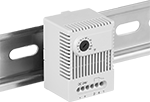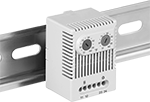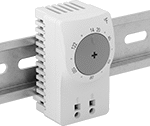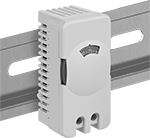Humidity and Temperature Transmitters

These sensors measure temperature and humidity, then send that information to your PLC or controller to regulate heating and cooling equipment, alarms, and data recorders. Choose a sensor that works with your digital IO-Link or analog 4-20 mA system. Clip it to a DIN rail or mount it to a surface, and use the micro M12 plug to connect the sensor to your controller. These sensors are often installed in enclosures.
Sensors meet American, Canadian, and European safety standards. Rated IP20, they’re designed so fingers can’t reach the electrical parts inside and get shocked. They also meet UL 94 V-0, so if they catch fire, they’ll self-extinguish within 10 seconds and won’t spread the fire by dripping.
Temperature | Relative Humidity | |||||||||||||||
|---|---|---|---|---|---|---|---|---|---|---|---|---|---|---|---|---|
| Range | Tolerance | Range | Tolerance | Communication Protocol | Output Current | Voltage | Ht. | Wd. | Dp. | Plug Type | For DIN Rail Height, mm | Mounting Fasteners Included | Environmental Rating | Specifications Met | Each | |
| -40° to 140° F -40° to 60° C | ±1.8° F ±1° C | 0% to 100% | ±4% | __ | 4-20mA | 24V DC | 5 1/2" | 1 1/2" | 1 1/2" | Micro M12 | 35 | No | IP20 | CE Marked; UL 94 V-0; VDE Certified; C-UL Recognized Component; UL Recognized Component | 0000000 | 0000000 |
| -40° to 175° F -40° to 80° C | ±0.54° F ±0.3° C | 0% to 100% | ±3% | IO Link | __ | 24V DC | 5 1/2" | 1 1/2" | 1 1/2" | Micro M12 | 35 | No | IP20 | CE Marked; UL 94 V-0; VDE Certified; C-UL Recognized Component; UL Recognized Component | 0000000 | 000000 |
DIN-Rail Mount Remote-Sensor Line-Voltage Thermostats


Place sensor in enclosures or different rooms than the rest of the thermostat to control temperature from outside the space. Thermostat works with line-voltage HVAC systems.
Enclosure Thermostats for Multiple Devices



Keep electronics in your enclosure from getting too hot or cold with these thermostats that control two devices at once. Clip them to a DIN rail to install.
Nonadjustable thermostats prevent tampering and accidental changes. Adjustable thermostats allow you to set custom temperatures.
Heating and cooling thermostats control heaters and fans or air conditioners. Thermostats with one actuation point, also known as changeover thermostats, switch between heating and cooling so one device is always running. When the temperature in your enclosure gets hotter than the temperature you set, the thermostat will turn on your fan or air conditioner. It goes back to heating once the temperature is reduced by the temperature difference. So for a thermostat with a temperature difference of 9° F, setting it at 60° F means it will heat the enclosure until it reaches 60° F, switch to cooling until it reaches 51° F, and then switch back to heating.
Heating and cooling thermostats with two actuation points control two devices independently. When your enclosure temperature is within the set range, neither device is powered, so they’re more efficient than changeover thermostats. For each device, temperature setting is the high end of the temperature range, and temperature difference is the size of the range. For a thermostat with temperature settings of 59° and 95° F and an 18° F temperature difference, the heater will switch on when your enclosure is colder than 41° F and turn off when it reaches 59° F. The fan or other cooling device will switch on when the temperature goes above 95° F and turn off once the enclosure cools to 77° F.
Cooling thermostats regulate two cooling devices, such as a fan and an air conditioner, for two-stage cooling. Use only one device for cooling in mild temperatures or both for extreme heat. These thermostats switch your equipment on when the enclosure is hotter than the temperature setting. Once the temperature is reduced by the temperature difference, it will switch off. For example, a thermostat set at 77° F for a fan and 140° F for an air conditioner will power both devices when the enclosure is over 140° F. With a temperature difference of 18° F, the air conditioner will switch off when the temperature goes below 122° F. The fan will run until the temperature reaches 59° F, and switch back on if it heats up to 77° F or hotter.
All thermostats meet IP20, which means they’re designed so fingers can’t fit inside and get shocked. They also meet UL 94 V-0, so they self-extinguish within 10 seconds if they catch on fire and won’t spread the fire by dripping. Thermostats that are CE marked or VDE certified meet European safety standards. UL Recognized Component and C-UL Recognized Component thermostats also meet American and Canadian safety standards.
Temperature | Overall | |||||||||
|---|---|---|---|---|---|---|---|---|---|---|
| Setting, °F | Difference, °F | Tolerance, °F | Voltage | Ht. | Wd. | Dp. | Environmental Rating | Specifications Met | Each | |
Adjustable | ||||||||||
| 32° to 140° | 5.4° | ±1.8° | 24V DC | 2 5/8" | 2" | 1 13/16" | IP20 | CE Marked, UL 94 V-0 | 0000000 | 000000 |
| 40° to 140° | 7° | ±1.8° | 120V AC | 2 9/16" | 1 5/8" | 1 1/2" | IP20 | CE Marked, CSA Certified, CSA-US Certified, UL 94 V-0 | 0000000 | 00000 |
| 40° to 140° | 9° | -5.4° to 3.6° | 120V AC | 2 5/8" | 2" | 1 1/2" | IP20 | CE Marked, UL Recognized Component, C-UL Recognized Component, UL 94 V-0 | 0000000 | 00000 |
| 40° to 140° | 9° | -5.4° to 3.6° | 240V AC | 2 5/8" | 2" | 1 1/2" | IP20 | CE Marked, UL Recognized Component, C-UL Recognized Component, UL 94 V-0 | 0000000 | 00000 |
Heating Temperature | Cooling Temperature | Overall | |||||||||||
|---|---|---|---|---|---|---|---|---|---|---|---|---|---|
| Setting | Difference | Tolerance | Setting | Difference | Tolerance | Voltage | Ht. | Wd. | Dp. | Environmental Rating | Specifications Met | Each | |
Nonadjustable | |||||||||||||
| 59° F/15° C | 18° F/10° C | ±9° F/±5° C | 95° F/35° C | 18° F/10° C | ±12.6° F/±7° C | 120V AC/240V AC 24V DC to 75V DC | 1 7/8" | 2 1/2" | 1 5/16" | IP20 | CE Marked, UL Recognized Component, C-UL Recognized Component, UL 94 V-0, VDE Certified | 0000000 | 000000 |
| 59° F/15° C | 18° F/10° C | ±9° F/±5° C | 122° F/50° C | 18° F/10° C | ±12.6° F/±7° C | 120V AC/240V AC 24V DC to 75V DC | 1 7/8" | 2 1/2" | 1 5/16" | IP20 | CE Marked, UL Recognized Component, C-UL Recognized Component, UL 94 V-0, VDE Certified | 0000000 | 00000 |
| 77° F/25° C | 18° F/10° C | ±9° F/±5° C | 122° F/50° C | 18° F/10° C | ±12.6° F/±7° C | 120V AC/240V AC 24V DC to 75V DC | 1 7/8" | 2 1/2" | 1 5/16" | IP20 | CE Marked, UL Recognized Component, C-UL Recognized Component, UL 94 V-0, VDE Certified | 0000000 | 00000 |
Adjustable | |||||||||||||
| 14° F to 122° F | 12.6° F | ±7° F | 68° F to 176° F | 12.6° F | ±7° F | 120V AC/240V AC | 2 5/8" | 2" | 1 13/16" | IP20 | CSA Certified, CE Marked, UL Recognized Component, C-UL Recognized Component, UL 94 V-0, VDE Certified | 0000000 | 00000 |
| 32° F to 140° F | 12.6° F | ±7° F | 32° F to 140° F | 12.6° F | ±7° F | 120V AC/240V AC | 2 5/8" | 2" | 1 13/16" | IP20 | CSA Certified, CE Marked, UL Recognized Component, C-UL Recognized Component, UL 94 V-0, VDE Certified | 0000000 | 00000 |
Cooling Temperature | Cooling Temperature | Overall | |||||||||||
|---|---|---|---|---|---|---|---|---|---|---|---|---|---|
| Setting | Difference | Tolerance | Setting | Difference | Tolerance | Voltage | Ht. | Wd. | Dp. | Environmental Rating | Specifications Met | Each | |
Nonadjustable | |||||||||||||
| 122° F/50° C | 18° F/10° C | ±12.6° F/±7° C | 140° F/60° C | 18° F/10° C | ±12.6° F/±7° C | 120V AC/240V AC 24V DC to 75V DC | 1 7/8" | 2 1/2" | 1 5/16" | IP20 | CE Marked, VDE Certified, C-UL Recognized Component, UL 94 V-0, UL Recognized Component | 0000000 | 000000 |
Adjustable | |||||||||||||
| 32° F to 140° F | 12.6° F | ±7° F | 32° F to 140° F | 12.6° F | ±7° F | 120V AC/240V AC | 2 5/8" | 2" | 1 13/16" | IP20 | CSA Certified, CE Marked, VDE Certified, C-UL Recognized Component, UL 94 V-0, UL Recognized Component | 0000000 | 00000 |
Enclosure Thermostats


Control a single heating or cooling device in your enclosure to keep electronics at a safe operating temperature. Clip them on to a DIN rail and connect them to your heater, fan, or air conditioner.
All these thermostats meet American, Canadian, or European safety standards. They have an IP20 rating—to prevent shocks, fingers won’t fit inside. They also meet UL 94 V-0, so they self-extinguish within 10 seconds if they catch fire and won’t spread the fire by dripping.
Adjustable thermostats let you set the temperature you need.
These thermostats keep the air in your enclosure within a set range. Temperature setting is the high end of the range for both heating and cooling thermostats. Heating thermostats are normally closed—when the air in your enclosure reaches the temperature setting, the thermostat will turn the heater off. Cooling thermostats are normally open, so they’ll switch your fan or air conditioner on when the air in your enclosure reaches the temperature setting.
Temperature difference is the difference between the temperature when the thermostat turns your device on and when it turns off. For a heater thermostat with a temperature setting of 50° and an 18° temperature difference, the thermostat will switch your heater on when the temperature goes below 32° and off once the temperature reaches 50°. Thermostats with a lower temperature difference maintain a narrower range of temperatures, but they use more power because they switch on and off more frequently.
Temperature | Overall | |||||||||||
|---|---|---|---|---|---|---|---|---|---|---|---|---|
| Setting | Difference | Tolerance | Voltage | Current, A | For DIN Rail Ht., mm | Ht. | Wd. | Dp. | Environmental Rating | Specifications Met | Each | |
For Cooling | ||||||||||||
Adjustable | ||||||||||||
| 14° to 122° F | 12.6° F | ±7° F | 120V AC/240V AC | 16 | 35 | 2.4" | 1.3" | 1.6" | IP20 | CE Marked, CSA Certified, UL 94 V-0, UL Recognized Component, C-UL Recognized Component, VDE Certified | 0000000 | 000000 |
| 32° to 140° F | 7° F | ±5.4° F | 120V AC/240V AC 24V DC to 75V DC | 16 | 35 | 2 13/16" | 1 5/16" | 1 11/16" | IP20 | CE Marked, UL 94 V-0 | 0000000 | 00000 |
| 32° to 140° F | 12.6° F | ±7° F | 120V AC/240V AC | 16 | 35 | 2.4" | 1.3" | 1.6" | IP20 | CE Marked, CSA Certified, UL 94 V-0, UL Recognized Component, C-UL Recognized Component, VDE Certified | 00000000 | 00000 |
For Heating | ||||||||||||
Adjustable | ||||||||||||
| 14° to 122° F | 12.6° F | ±7° F | 120V AC/240V AC | 16 | 35 | 2.4" | 1.3" | 1.6" | IP20 | CE Marked, CSA Certified, UL 94 V-0, UL Recognized Component, C-UL Recognized Component, VDE Certified | 0000000 | 00000 |
| 32° to 140° F | 7° F | ±5.4° F | 120V AC/240V AC 24V DC to 75V DC | 16 | 35 | 2 13/16" | 1 5/16" | 1 11/16" | IP20 | CE Marked, UL 94 V-0 | 0000000 | 00000 |
| 32° to 140° F | 12.6° F | ±7° F | 120V AC/240V AC | 16 | 35 | 2.4" | 1.3" | 1.6" | IP20 | CE Marked, CSA Certified, UL 94 V-0, UL Recognized Component, C-UL Recognized Component, VDE Certified | 000000 | 00000 |

























